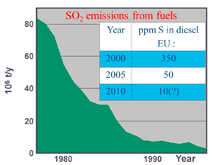Project period: 2013-2017
The purpose of this project is to design and develop new HydroDeSulfurization (HDS) catalysts with the appropriate structural configuration so it is possible to remove sulphur from fuels to below the 1 ppm limit. Current HDS catalysts are not capable of removing the last 10 ppm of sulphur since it is hiding in steric hindered molecules such as Dibenzothiophene (DBT) and 4,6-Dimethyldibenzothiophene (DMDBT). The catalyst development will be based on a rational design through a combination of fundamental methods such as DFT calculations, structural investigations using atomically resolved methods like Scanning Probe Microscopy (SPM) and Transmission Electron Microscopy (TEM), combined with activity measurements in a newly developed micro reactor platform that allow for a direct correlation in between structure and activity on model systems. Resulting catalysts will be tested under industrial conditions.
Sulphur is naturally present in small quantities in petroleum and coal. Sulphur dioxide (SO2) has been recognised for decades as a major cause of the "acid rain" and air pollution which affect urban and industrial areas. More recently, it has been recognised that SO2 emissions contribute to the formation of secondary inorganic aerosol gases, fine particles which are harmful to human health. It is therefore highly desirable to completely avoid emission of sulphur in the environment. HDS catalysis has had a tremendous impact on the environment since it removes sulphur from refinery products. Strong regulations and the advent of increasingly effective HDS catalysts has reduced this problem substantially - as shown in the figure;
 |
| The positive development of SO2 emission from fuels due to HDS |
The problem is however the question mark in the figure for the 10 ppm, as it is a result of limitations of the HDS catalysts which are not particularly efficient for removing sulphur from compounds like (DBT) and (DMDBT) which constitute a good part of the remaining sulphur. The hypothesis is that this problem may be caused by steric hindered since the sulphur is deeply buried in the molecular structure of these remaining molecules.
The purpose of this project is therefore, by nanoscale engineering on the atomic level, to design catalysts that can access and react with this sulphur and ensure removal of the last 10 ppm i.e. deep HDS. Such a catalyst is naturally also foreseen to have a positive effect on removal of the other sulphur containing compounds leading to an overall improvement of the catalyst performance and general cost reduction.
Designing catalyst on the molecular level is the “Holy grail” of catalysis and is an area which has a tremendous impact both in science and in technology due to its importance for society. It is judged that catalysis is involved in some 20% of GNP and in roughly some 90% of all chemical production. The participants in this proposal have an excellent record in investigating such fundamental aspect and at the same time relate them to technological important large scale processes such as Steam reforming, Carbon growth, Methanol synthesis, Hydrogen Evolution, and HDS, just to mention some of the more spectacular and highly cited contributions. In this proposal we plan to take this important area of science and technology even further combing the newest and most sophisticated methods available on an international level. This project will thus lead to better protection of the environment, increased scientific insight, and education of PhDs.